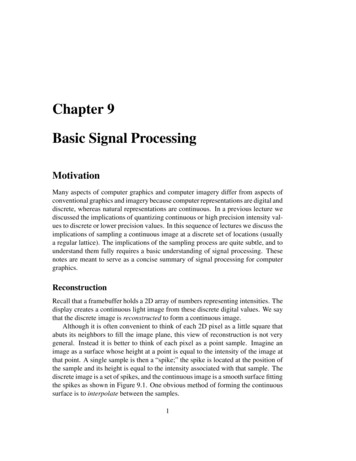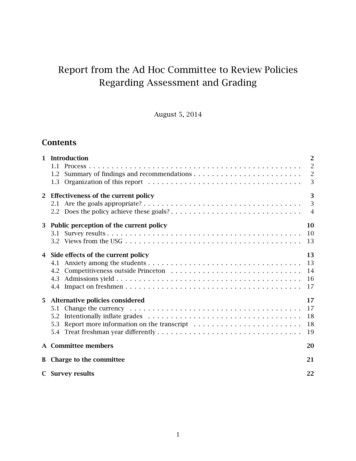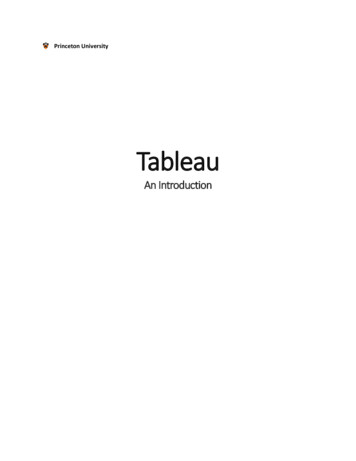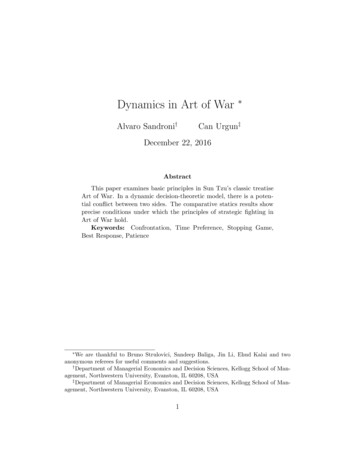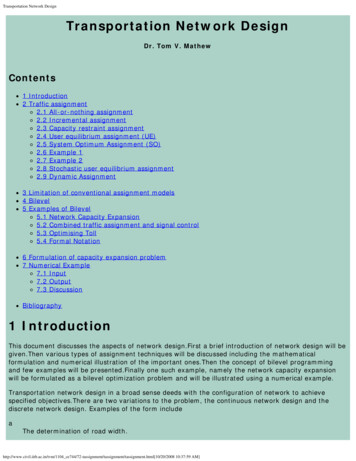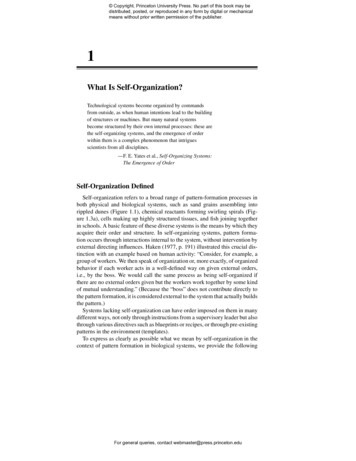
Transcription
Copyright, Princeton University Press. No part of this book may bedistributed, posted, or reproduced in any form by digital or mechanicalmeans without prior written permission of the publisher.1What Is Self-Organization?Technological systems become organized by commandsfrom outside, as when human intentions lead to the buildingof structures or machines. But many natural systemsbecome structured by their own internal processes: these arethe self-organizing systems, and the emergence of orderwithin them is a complex phenomenon that intriguesscientists from all disciplines.—F. E. Yates et al., Self-Organizing Systems:The Emergence of OrderSelf-Organization DefinedSelf-organization refers to a broad range of pattern-formation processes inboth physical and biological systems, such as sand grains assembling intorippled dunes (Figure 1.1), chemical reactants forming swirling spirals (Figure 1.3a), cells making up highly structured tissues, and fish joining togetherin schools. A basic feature of these diverse systems is the means by which theyacquire their order and structure. In self-organizing systems, pattern formation occurs through interactions internal to the system, without intervention byexternal directing influences. Haken (1977, p. 191) illustrated this crucial distinction with an example based on human activity: “Consider, for example, agroup of workers. We then speak of organization or, more exactly, of organizedbehavior if each worker acts in a well-defined way on given external orders,i.e., by the boss. We would call the same process as being self-organized ifthere are no external orders given but the workers work together by some kindof mutual understanding.” (Because the “boss” does not contribute directly tothe pattern formation, it is considered external to the system that actually buildsthe pattern.)Systems lacking self-organization can have order imposed on them in manydifferent ways, not only through instructions from a supervisory leader but alsothrough various directives such as blueprints or recipes, or through pre-existingpatterns in the environment (templates).To express as clearly as possible what we mean by self-organization in thecontext of pattern formation in biological systems, we provide the followingFor general queries, contact webmaster@press.princeton.edu
Copyright, Princeton University Press. No part of this book may bedistributed, posted, or reproduced in any form by digital or mechanicalmeans without prior written permission of the publisher.8 – WHAT IS SELF-ORGANIZATION?definition: Self-organization is a process in which pattern at the global levelof a system emerges solely from numerous interactions among the lower-levelcomponents of the system. Moreover, the rules specifying interactions amongthe system’s components are executed using only local information, withoutreference to the global pattern. In short, the pattern is an emergent propertyof the system, rather than a property imposed on the system by an external ordering influence. Emergent properties will be defined in later chapters, but fornow suffice to say that emergent properties are features of a system that ariseunexpectedly from interactions among the system’s components. An emergentproperty cannot be understood simply by examining in isolation the propertiesof the system’s components, but requires a consideration of the interactionsamong the system’s components. It is important to point out that system components do not necessarily have to interact directly. As described in Chapter 2,and Figure 2.4, individuals may interact indirectly if the behavior of one individual modifies the environment and thus affects the behavior of other individuals.Pattern in Group ActivitiesCritical to understanding our definition of self-organization is the meaningof the term pattern. As used here, pattern is a particular, organized arrangementof objects in space or time. Examples of biological pattern include a school offish, a raiding column of army ants, the synchronous flashing of fireflies, andthe complex architecture of a termite mound. Examples of other biologicalpatterns include lichen growth (Figure 1.2a), pigmentation patterns on shells,fish and mammals (Murray 1988, Meinhardt 1995), (Figures 1.2b,c,d) and theocular dominance stripes in the visual cortex of the macaque monkey brain(Hubel and Wiesel 1977) (Figure 1.2e).To understand how such patterns are built, it is important to note that insome cases the building blocks are living units — fish, ants, nerve cells, etc. —and in others they are inanimate objects such as bits of dirt and fecal cementthat make up the termite mound. In each case, however, a system of livingcells or organisms builds a pattern and succeeds in doing so with no externaldirecting influence, such as a template in the environment or directions froma leader. Instead, the system’s components interact to produce the pattern, andthese interactions are based on local, not global, information. In a school offish, for instance, each individual bases its behavior on its perception of theposition and velocity of its nearest neighbors, rather than knowledge of theglobal behavior of the whole school. Similarly, an army ant within a raidingcolumn bases its activity on local concentrations of pheromone laid down byother ants rather than on a global overview of the pattern of the raid.The literature on nonlinear systems often mentions self-organization, emergent properties, and complexity as well as dissipative structures and chaosFor general queries, contact webmaster@press.princeton.edu
Copyright, Princeton University Press. No part of this book may bedistributed, posted, or reproduced in any form by digital or mechanicalmeans without prior written permission of the publisher.CHAPTER 1 – 9Figure 1.2ab(i)b(ii)Figure 1.2 Self-organized patterns in biological systems include: (a) lichen growth;(b) pigmentation of a porphyry olive shell (Olivia porphyria) (i) and a marble coneshell (Conus marmoreus) (ii); (Figure 1.2 continued next page)For general queries, contact webmaster@press.princeton.edu
Copyright, Princeton University Press. No part of this book may bedistributed, posted, or reproduced in any form by digital or mechanicalmeans without prior written permission of the publisher.10 – W H A T I S S E L F - O R G A N I Z A T I O N ?Figure 1.2 continuedcd(c) skin pigmentation on fish (clockwise from top—vermiculated rabbitfish (Siganusvermiculatus), male boxfish (Ostracion solorensis), and surgeonfish (Acanthurus lineatus)); (d) zebra and giraffe coat patterns. (Figure 1.2 continued next page)For general queries, contact webmaster@press.princeton.edu
Copyright, Princeton University Press. No part of this book may bedistributed, posted, or reproduced in any form by digital or mechanicalmeans without prior written permission of the publisher.C H A P T E R 1 – 11Figure 1.2 continued(e) ocular dominance stripes in the visual cortexof the macaque monkey (from Hubel and Wiesel1977). Cortical regions receiving inputs from oneof the monkey’s eyes are shown in black whileregions receiving inputs from the other eye arerepresented by white regions between the blackstripes.e(Prigogine and Glansdorf 1971; Nicolis and Prigogine 1989). The terms chaosand dissipative structures have precise scientific meanings that may differ frompopularized definitions, so it is important to discuss these terms at this point.To begin with, the term complex is a relative one. Individual organisms mayuse relatively simple behavioral rules to generate structures and patterns atthe collective level that are relatively more complex than the components andprocesses from which they emerge. As discussed in Chapter 6 (see Box 1),systems are complex not because they involve many behavioral rules and largenumbers of different components but because of the nature of the system’sglobal response. Complexity and complex systems, on the other hand, generally refer to a system of interacting units that displays global properties notpresent at the lower level. These systems may show diverse responses that areoften sensitively dependent on both the initial state of the system and nonlinearinteractions among its components. Since these nonlinear interactions involveamplification or cooperativity, complex behaviors may emerge even though thesystem components may be similar and follow simple rules.Complexity in a system does not require complicated components or numerous complicated rules of interaction.Self-Organization in BiologyThe concept of self-organization in biological systems can be conveyedthrough counterexamples. A marching band forming immense letters on a football field provides one such example. Here the band’s members are guided intheir behavior by a set of externally imposed instructions for the movementsFor general queries, contact webmaster@press.princeton.edu
Copyright, Princeton University Press. No part of this book may bedistributed, posted, or reproduced in any form by digital or mechanicalmeans without prior written permission of the publisher.12 – W H A T I S S E L F - O R G A N I Z A T I O N ?of each band member that specify in fine detail the final configuration of thewhole band. A particular member of the band may know that the instructionsare to march to the 50-yard line, turn left 90 degrees and march 10 paces. Tothe extent that the band member follows this recipe for contributing to the pattern and ignores local information, such as position relative to neighbors, thispattern formation would not be considered self-organized.Similarly, a team of carpenters building a house is a pattern-formation process that functions without self-organization. Here members of the construction crew are guided in their collective behavior by predetermined externallyimposed instructions expressed as blueprints, that precisely specify the finalstructure of the house. Letter formation by a marching band and house construction by a construction crew both involve pattern building in space.Let us also consider two counterexamples to self-organization that involvepattern building over time. One such example is oarsmen in a rowing teampulling on their oars in perfect synchrony with one another and with appropriate adjustments of their stroke frequency. This pattern arises when each oarsman responds to the coxswain’s shouted instructions indicating when to begineach stroke. Clearly, this is an example of a group generating a pattern by following explicit orders from a leader based on the overall state of the groupmembers. The rhythmic contractions of muscle fibers in the heart are also acounterexample to self-organization. Here the pattern arises as the componentbuilding blocks (the muscle fibers), follow instructions from special excitablecells that act as an external pacemaker and send a rhythmic electrical signal tothe fibers.1We can easily see how a system can form a precise pattern if it receivesinstructions from outside—such as a blueprint, recipe, or signals from apacemaker—but it is less obvious how a definite pattern can be produced inthe absence of such instructions. A general answer to this puzzle is provided inthe next chapter, while specific answers for particular biological patterns constitute the main body of this book. For now, it is merely asserted that patternformation often is achieved by systems without external guidance.The mechanisms of self-organization in biological systems differ from thosein physical systems in two basic ways. The first is the greater complexity ofthe subunits in biological systems. The interacting subunits in physical systemsare inanimate objects such as grains of sand or chemical reactants. In biological systems there is greater inherent complexity when the subunits are livingorganisms such as fish or ants or neurons.The second difference concerns the nature of the rules governing interactions among system components. In chemical and physical systems, patternis created through interactions based solely on physical laws. For example,heat applied evenly to the bottom of a tray filled with a thin sheet of viscousoil transforms the smooth surface of the oil into an array of hexagonal cellsof moving fluid called Bénard convection cells (Figure 1.3) (Velarde and Nor-For general queries, contact webmaster@press.princeton.edu
Copyright, Princeton University Press. No part of this book may bedistributed, posted, or reproduced in any form by digital or mechanicalmeans without prior written permission of the publisher.C H A P T E R 1 – 13abFigure 1.3 Further examples of self-organized patterns in physical and chemical systems: (a) hexagonal Bénard convection cells created when a thin sheet of viscous oil isheated uniformly from below. Aluminum powder was added to the oil to show the convection pattern; and (b) spiral patterns produced by the Belousov-Zhabotinski reaction.The chemistry of the reaction is explained by Winfree (1972, 1984). (Image courtesyof Stefan C. Müller)mand 1980). The molecules of oil obey physical laws related to surface tension,viscosity, and other forces governing the motion of molecules in a heated fluid.Likewise, when wind blows over a uniform expanse of sand a pattern of regularly spaced ridges is formed (Figure 1.1) through a set of forces attributableto gravity and wind acting on the sand particles (Anderson 1990; Forrest andHaff 1992).Of course, biological systems obey the laws of physics, but in addition tothese laws the physiological and behavioral interactions among the living components are influenced by the genetically controlled properties of the components. In particular, the subunits in biological systems acquire informationabout the local properties of the system and behave according to particular genetic programs that have been subjected to natural selection. This adds an extradimension to self-organization in biological systems, because in these systemsselection can finel
the extent that the band member follows this recipe for contributing to the pat-tern and ignores local information, such as position relative to neighbors, this pattern formation would not be considered self-organized. Similarly, a team of carpenters building a house is a pattern-formation pro- cess that functions without self-organization. Here members of the construc-tion crew are guided in





